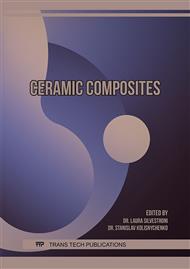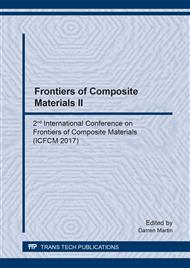p.40
p.47
p.51
p.56
p.61
p.66
p.72
p.79
p.84
Influence of Compaction Pressure on Density, Bending Strength, and Microstructures of Al2O3-SiC-ZrO2 Ceramic Matrix Composites with Nb2O5 Additives
Abstract:
Ceramic matrix composites (CMCs) are known to have high hardness, temperature and corrosion resistance, while being comparatively lightweight. One of many external factors that influence the mechanical properties of CMC is the compaction pressure given during fabrication process. Generally, greater amount of applied compaction pressure will result in improved final product density and bending strength. In this research, a type of CMCs was fabricated using Al2O3, SiC, and ZrO2 powder mixed with Nb2O5 additive of 81Al2O3-10SiC-5ZrO2-4Nb2O5 wt. % composition. Fabrication was done through mixing, compacting, and sintering process. Compaction was performed at 257, 308, and 359 MPa and finished with sintering process at 1400 °C for 4 h. Final samples were characterized by density measurement, 3-point bending strength testing, XRD for phase investigation, and microstructure observation using SEM-EDS. Results showing that samples with 308 MPa compaction pressure possessed the highest density and bending strength of 3.29 gr/cm3 and 14.91 MPa, respectively. These numbers however, declined on samples with higher compaction pressure of 359 MPa due to the formation of porosities caused by entrapped gas that failed to exit the sample of which compaction pressure was considered to be overwhelmingly high.
Info:
Periodical:
Pages:
61-65
Citation:
Online since:
May 2018
Keywords:
Price:
Сopyright:
© 2018 Trans Tech Publications Ltd. All Rights Reserved
Share:
Citation:



